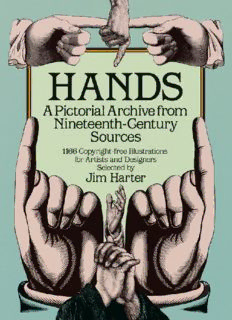
Hands: A Pictorial Archive from Nineteenth-Century Sources PDF
Preview Hands: A Pictorial Archive from Nineteenth-Century Sources
HANDS A PICTORIAL ARCHIVE FROM NINETEENTH-CENTURY SOURCES 1166 Copyright-free Illustrations for Artists and Designers DOVER PUBLICATIONS, INC. New York PUBLISHER’S NOTE Wood engravings, with their crisp black-and-white lines, were popularized by Thomas Bewick at the end of the eighteenth century and quickly became the favored medium of mass reproduction of artwork in the nineteenth. While there were only about 20 wood engravers in the United States in 1838, by 1870 their number had swelled to about 400. Most of them earned their living by engraving illustrations for the great periodicals of the era, Harper’s Weekly and Leslie’s Illustrated foremost among them. With great skill the artists rendered sketches and photographs into precise illustrations. The medium admitted a wide variety of styles from simple, bold line drawings to those so carefully worked that the effect of gradation of tone was achieved, sometimes with an impressionistic feeling. By the mid-1880s the means had become available for reproducing photographs as halftone illustrations, but they were both crude and expensive. It was not until the 1890s that the art of wood engraving began to be superseded by the new process. Ironically, now that the technique of the wood engraving has been largely lost, the popularity of these illustrations is reviving. Artists find the material widely adaptable to projects such as collage. Graphic designers are rediscovering how well the engravings complement typography. Using his keen eye, artist Jim Harter has for this selection carefully drawn upon numerous books and periodicals, many difficult to locate, including Chatterbox, Die Frau als Hausärztin, Illustrated London News, LaNature, Scientific American and Tom Tit. The material reflects a range of different effects that could be achieved by wood engraving, as well as the diversity of the subject. A few engravings that predate the nineteenth century have been included by way of contrast. Planned to be of maximum use to artists and designers, this collection reveals the expressiveness and loveliness of the human hand in an exceptional variety of contexts, including writing, sewing, demonstrating scientific experiments, using tools, performing magic tricks, applying first aid, playing parlor games and even casting hand shadows on the wall. Hands are displayed to demonstrate palmistry, anatomy and the deaf-mute language, or are simply poised to reveal their beauty or sturdy dignity. In response to the demand for hands with pointing fingers, a large selection of these in various types and sizes has been included. Copyright © 1985 by Dover Publications, Inc. All rights reserved under Pan American and International Copyright Conventions. Hands: A Pictorial Archive from Nineteenth-Century Sources is a new work, first published by Dover Publications, Inc., in 1985. Pictorial Archive DOVER SERIES This book belongs to the Dover Pictorial Archive Series. You may use the designs and illustrations for graphics and crafts applications, free and without special permission, provided that you include no more than ten in the same publication or project. (For permission for additional use, please write to Dover Publications, Inc., 31 East 2nd Street, Mineola, N.Y. 11501.) However, republication or reproduction of any illustration by any other graphic service whether it be in a book or in any other design resource is strictly prohibited. Manufactured in the United States of America Dover Publications, Inc., 31 East 2nd Street, Mineola, N.Y. 11501 Library of Congress Cataloging in Publication Data Harter, Jim. Hands : a pictorial archive from nineteenth-century sources. (Dover pictorial archive series) 1. Hand in art. 2. Wood-engraving, American. 3. Wood-engraving—19th century—United States. I. Title. II. Series. NE962.H35H37 1985 769'.42 85-12906 eISBN-13: 978-0-4861-3413-0 Contents Hands Hands
Description: